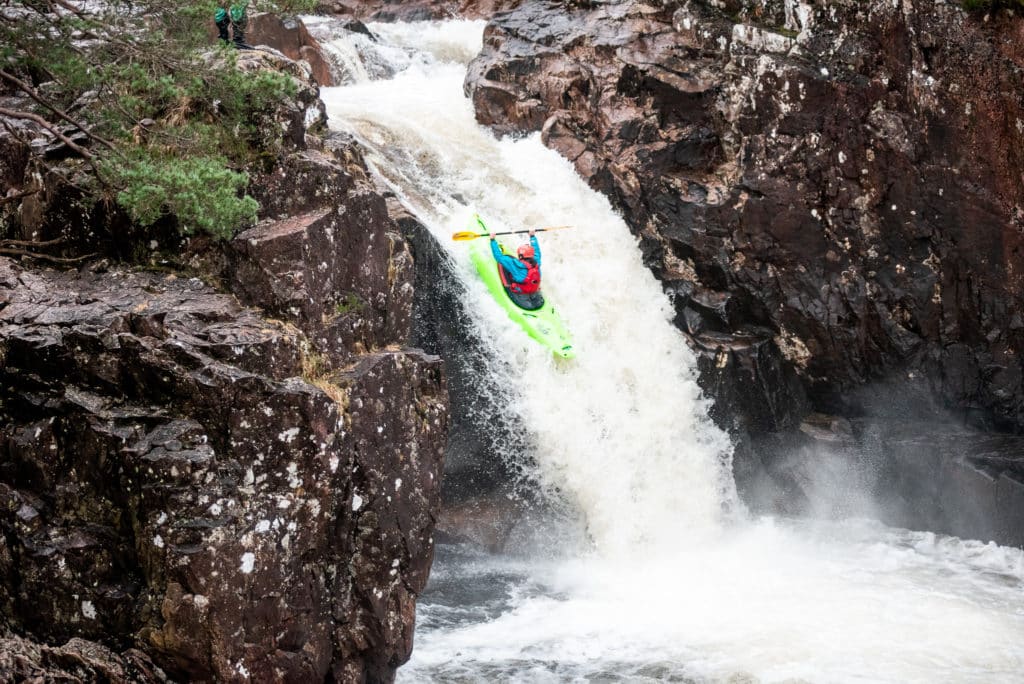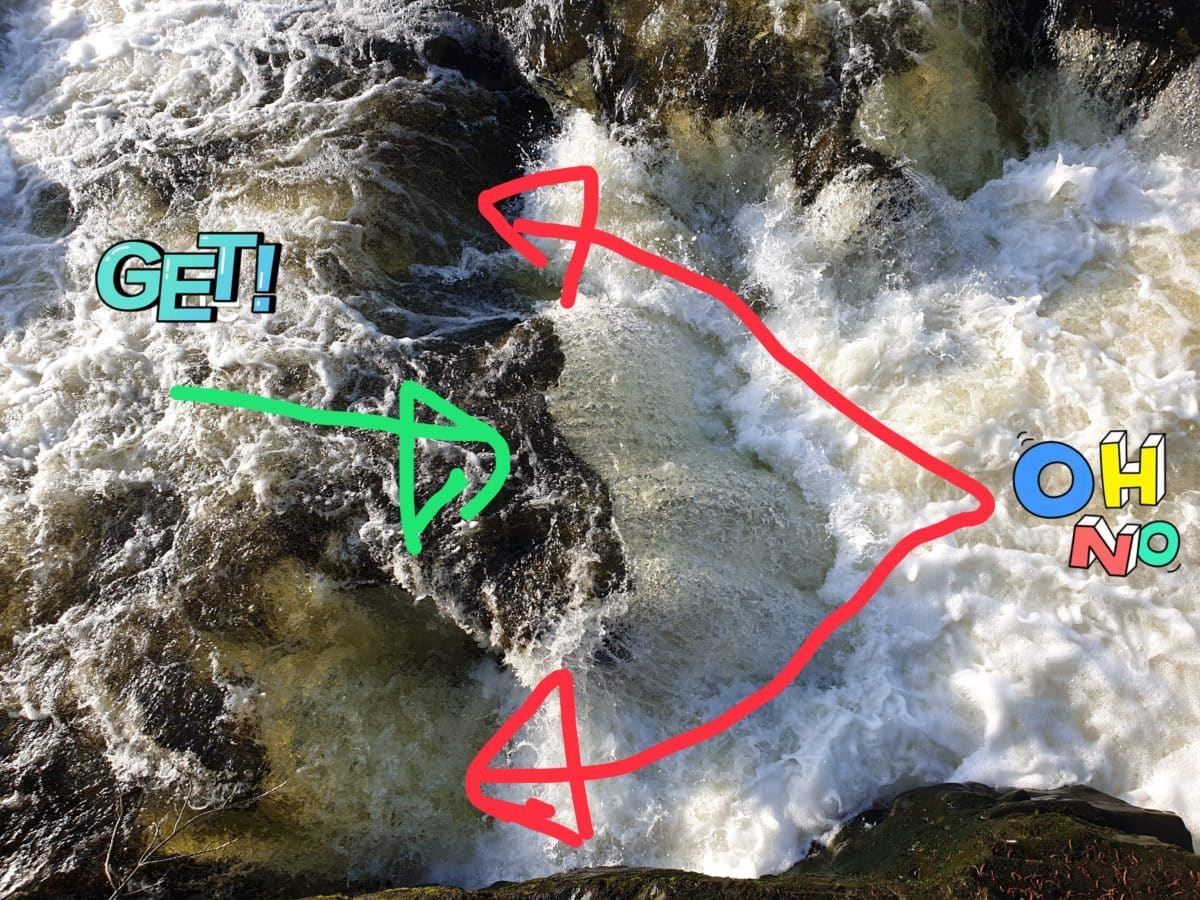Last week I started a series of posts on how to become an independent boater, i.e. someone who doesn’t need to be led down the river. I looked at safety in my last piece and you can read it here. This week is all about picking your own lines and why this is so important in being able to move away from being led on a river. When talking about lines, I mean the route you take to get from point A to point B on a river. This may be planned out, for example if you get out of your kayak to scout an upcoming rapid. Lines can also be chosen very quickly and from your boat whilst you are paddling down a river. Either way, being able to choose your line is an important skill than can take people a long time to master.
White water as a beginner
Learning to kayak in my opinion is very similar to when you first learn to drive. Initially you are so focused on the mechanics of making your vessel move, that it is really hard to pay much attention to your surroundings. This of course improves with experience. However that time at the very start of your paddling journey will no doubt be filled with people telling you what to do. ‘Follow me’, ‘go that way’, ‘paddle down the right’, ‘aim for that rock’ and so on are examples of instructions you will hear new paddlers being told. Whilst these clear directions may be helpful at the time, it does mean that the directed paddler can have made it down a rapid/river without having paid much attention to the white water that they were paddling on. So whilst you are building up your experience on rivers, you are not necessarily building up your experience of reading white water. This means that you may end up reacting to the white water if something unexpected occurs and not know what to do in this unplanned situation. (Getting stuck in a hole you were supposed to go around is a common example that springs to mind).

Starting off small
So how do you move from being told where to go to choosing for yourself? Well my advice would be to start off small. If your group gets out to scout a rapid, make sure you spend some time really looking at the water and trying to predict what might happen at each point. All the water coming in from the right – where will it push you? And so on. Then think to yourself what are you going to do to stop that from happening. Where is it that you want to be on the water and how are you going to ensure that you get there? A friend advised me many years ago that when it comes to picking your line, start at the bottom of the rapid and work your way up. I found this really helpful but accept it won’t be everyone’s preferred method. Once you have an idea of where you think you should go, only then discuss with the others in your group. It is easy in the beginning to wait for someone else to make a suggestion and then just agree with them. But if you really want to pick your own lines, you need to spend that time thinking independently. It is really hard at first but if you practice this at every opportunity, it does get easier. You don’t always need to practice on real lines either – picking fantasy lines on rapids you know you won’t run is a great stress-free way to practice!

Link to my Norway blog here.
Transferring these skills
Once you get used to reading white water and picking lines from the bank you can then transfer these skills to whilst you are on the water. For some rivers it is not possible to pick all of your lines from the bank because the rapids are too continuous. The Aberglaslyn Gorge is a UK river that comes to mind in regards to this. This is a fantastic stretch of white water which, depending on water levels, is considered continuous grade 4. Whilst you can see all of the rapids from the bank, my memory is far too poor to be able to memorise all of the lines. So instead of pre-picking lines, I chose my lines whilst I am on the water. This is known as ‘read and run’ and is one of my favourite types of kayaking.

At first, kayaking in a read and run situation, can feel very full on. I found that I could fall into ‘survival mode’. This is when you are so focused on getting through the rapids that you stop being aware of your surrounding. I know when I start focusing on what is directly in front of my kayak instead of looking at the whole river that I am losing control. In this instance, I have started reacting to the water instead of actively choosing where I am paddling. Whereas if you keep the whole river at the front of your mind, you are constantly picking your future lines and using the features of the river to help you achieve this.
Another time you may need to choose your own lines on the river is when something goes wrong. Perhaps you had chosen your line but then been pushed off course half way down the rapid. If you panic because you no longer know where to go, chances are, you might end up in trouble (upside down). If you stay calm and assess what your new line will be, chances are, you will end up paddling that new line. Being able to adapt your kayaking to a changing situation is a very important tool.

Why I think this is important
The reason I think being able to pick your own lines is so important is because I identify it as one of the bridges that I had to cross to be able to improve in my own paddling. It is also something that I would say is a more recent (in the last two years) development for me. Whilst I may still have a long way to work on my technical skills, I would say that choosing lines is a strength of my paddling at the moment. Because I spend so much of my time on the water, I have built up a lot of experience. I may not always style it as much as some of my more technically talented paddle buddies but I now trust my decision making on a river a lot more. It is also something that has increased my confidence and calmed my nerves whilst kayaking. Knowing that I have the skills to make my own decisions, even when things change, is something that really helps me on the water.

Even if you have really strong technical skills, if you are unable to choose your own lines on a river, then you are still having to be led. Reading white water and making decisions based on your readings is just as an important skill as the technical kayaking skills. It is also, in my opinion, the second key step to becoming an independent boater.
Wait for next week to find out the third and final step!

2 replies on “Picking your own lines – the second step to becoming an ‘independent boater’”
[…] piece was on the importance of being safe. My second piece was on the importance of being able to choose your own lines. My third and final piece is going to be on the importance of friends. Kayaking is a unique sport […]
[…] Picking your own lines was an article I wrote as part of a trilogy of posts about how to become an independent boater. The other two posts focused on safety and friendships. I think perhaps this article was popular as being able to read whitewater and choose your own line to take is a skill that is actually quite challenging. I would in no way say I am an expert on this but I would always much rather choose my own line than be told what the line was. It is a skill that takes a lot of practice but definitely one worth investing in. Check out the article if you would like to read more. […]